
Part II
How They Do It and How to Keep Seahorses Looking Their Best and Brightest
by
Pete Giwojna and Ben Giwojna
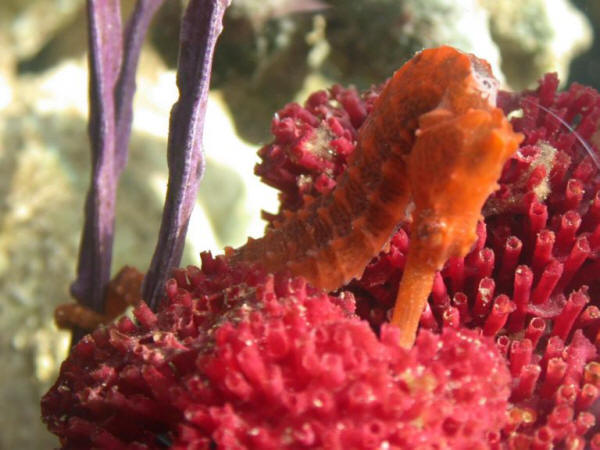 |
|
This bright
red-orange Ocean Rider Sunburst (Hippocampus
erectus)
nearly matches the color of the pipe organ coral it is scrutinizing
closely for 'pods. You can never tell what might catch a
seahorses eye and trigger a corresponding color change, so try to
select colorful natural decor for your seahorse tank."
Photo by Leslie Leddo |
In the first part of this article we explored
some of the ways seahorses employ their remarkable ability to change coloration.
We discussed how our amazing aquatic equines rely on color for camouflage, their
complex social interactions and courtship rituals, and to express their mood and
emotional state. Now that we have laid the groundwork, we can examine what
gives the seahorse its chameleon-like abilities and explore some of the things
aquarists can do to help kep their seahorses looking their best and brightest.
Hippocampus
accomplishes its dramatic color changes through the contraction or expansion of
pigment cells known as chromatophores. Each chromatophore is a contractile cell
or vesicle containing liquid pigment or pigment granules and capable of changing
its form or size, thus causing changes of color in the skin of the animals that
possess them. The chromatophores may be under nervous control and able to
change very rapidly or under hormonal control and able to change only relatively
slowly.
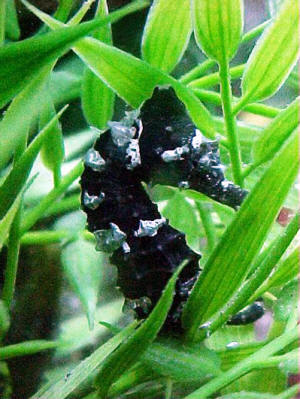 |
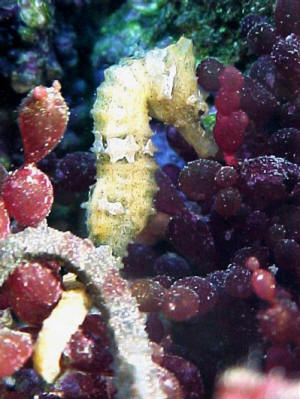 |
|
This beautiful black-and-white Hippocampus erectus was given the
nickname "Oreo" for obvious reasons. Photo by Leslie Leddo |
This is another picture of "Oreo" taken less than a day later As
you can see, he has transformed himself from a black seahorse to a
white seahorse literally overnight. It is normal for seahorses to
display different color phases from time to time. Photo by Leslie
Leddo |
|
Night and Day: as shown below, this little seahorse has completely
changed his coloration in a matter of hours. This is a dramatic
example of how quickly seahorses can change colors. |
In seahorses, the chromatophores are branched
(dendritic) cells, within which the color pigment can be moved (Tamaru, Sep.
2001). When a chromatophore contracts, all of its pigment is concentrated
in one small spot in the center of the cell, resulting in the loss of color in
the fish (Tamaru, Sep. 2001). When a chromatophore expands, the
pigment spreads throughout the entire cell to all its branches, resulting in
bright color (Tamaru, Sep. 2001). Muscles attached to the chromatophores
can also move the pigment cells a little closer to or a little further away from
the surface of the skin (Walls, 2004). When the pigment cells are close to
the surface of the skin, the color is bright and clear; when the pigment cells
are further away from the surface, the color is muted and more diffuse.
 |
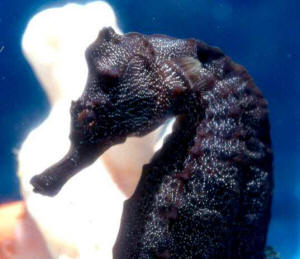 |
|
Golden Giant: as
shown by this fine specimen, Ocean Rider's strain of
captive-bred-and-raised Pacific giant seahorses (Hippocampus
ingens)
are typically a brilliant yellow in coloration."
Photo by Dr. Clyde
Tamaru
|
Black Beauty: the
melanistic form of the Gigante (Hippocampus
ingens)
is a solid jet black in coloration from head-to-tail because the
only pigment it can produce is melanin. It is the same species as
the brilliant yellow seahorses in the previous photograph, yet its
coloration is completely different due to the different type of
chromatophores it possesses."
Photo by Dr. Clyde
Tamaru |
Different types of chromatophores contain
different pigments such as melanin (black), xanthin (yellow), lipochrome
(orange), erythrin (red) and so on (Cusick, 2004). The different types of
chromatophores are named according to the type of pigment they contain (e.g.,
melanophores, erythrophores and xanthophores). These specialized pigment
cells are usually stacked upon each other or clustered in groups (Tamaru, Sep.
2001).
Hippocampus is typically endowed with just a few different types of
chromatophores, and all other colors are derived from these 3 or 4 basic
pigments. The exact color the seahorse displays at any given time
therefore depends on the concentration of these pigment cells, how close the
cells are to the surface of the skin, and which chromatophores are expanded or
contracted at the moment (Cusick, 2004).
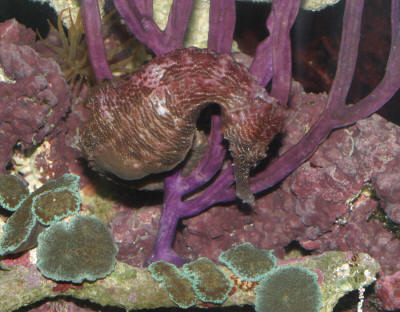
This Ocean Rider
seahorse has begun to assume a purplish tinge to better blend in with the
coralline algae and gorgonians that adorn its aquarium. When selecting
live rock for your seahorse tank, look for pieces that are heavily overgrown
with pink and purple coralline algae.
Photo by Leslie Leddo
For example, seahorses have no blue pigment
cells, but the color blue can be approximated nonetheless. A low
concentration of melanin (black pigment) deep in the dermal layer gives the skin
of the fish a bluish cast (Cusick, 2004). Achieving a blue tint in
this way while simultaneously expanding xanthophores (yellow pigment cells)
produces shades of green, and maintaining a bluish background color while
opening erythrophores (red pigment cells) yields shades of purple and violet.
Likewise, a seahorse that has no orange pigment cells can still assume a bright
orange coloration by simultaneously expanding its xanthophores (yellow pigment
cells) and erythrophores (red pigment cells) to the fullest. The exact
shade of orange it becomes and its brightness is determined by the proportion of
yellow to red cells it opens, how fully they are expanded, and how close to the
skin's surface they are. Obviously, a seahorse that is black has all its
melanophores expanded and a seahorse that is white has ALL of its chromatophores
contracted so that all the wavelengths of visible light are reflected back to
the observer, and so on.
In seahorses, melanophores are the most common of
these pigment cell types (Tamaru, Sep. 2001). They contain the pigment
melanin, which gives most seahorses their typical black or dark brown
coloration. Essentially melanin absorbs the entire visible light spectrum
and looks black because no light is reflected back to the observer (Tamaru, Sep.
2001). When a melanophore is open and fully expanded, the melanin it
contains is dispersed throughout the cell, and when all the melanophores are
opened at once, melanin is distributed evenly across the surface of skin,
rendering the seahorse black (Tamaru, Sep. 2001). Seahorses typically
respond to stress by expanding their melanophores and darkening this way.
The different types of pigment cells seahorses
possess vary from species to species. Hence, not all seahorses have the
same palette of colors at their disposal. Some seahorses can never turn
red because they lack erythrophores; red is simply not in their wardrobe.
In general, tropical seahorses tend to have brighter colors in their repertoire
than temperate species. And deep-water seahorses often have more red and
orange pigment cells than other seahorses. In order words, different
seahorse species have different coloration due to the differential proliferation
of chromatophore cell types.
Depending on the species, the results can be very
striking. For example, the painted seahorse (Hippocampus syndonis)
from Japan can adorn itself in a psychedelic or Harlequin-like pattern of
riotous colors ranging from the richest crimson to brilliant saffron yellow
(Walls, 2004). Of course, the flamboyant reddish, bright yellow, and
blazing orange color morphs of the Brazilian seahorse (H. reidi) are
almost legendary among aquarists. Nowadays, a boldly colored Pinto or
dazzling SunFire from Ocean Rider is the crown jewel in many a seahorse keeper’s
collection. And almost all species of seahorses can adopt cryptic
coloration featuring contrasting blotches, splotches, saddles, stripes, bars,
speckles, lines and dots that serve to break up their silhouette and disguise
their shape (walls, 2004).
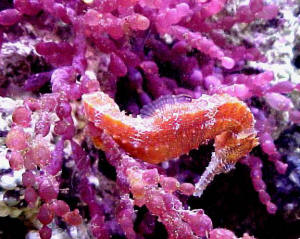 |
|
Mustangs (Hippocampus
erectus)
tend to be dark color due to a preponderance of melanophores, but
they also have bright pigment cells and can brighten up when the
occasion calls for it, as shown by this pretty 'stang.
Photo by Leslie Leddo |
Some species of seahorses such as H. erectus
have been captive-bred-and-raised for more than 20 generations and domesticated
seahorses are now available in virtually every color of the rainbow.
However, most strains of colorful cultured seahorses are not homozygous
recessives nor are they mutations that are unable to manufacture certain
pigments altogether. But they have been selectively bred to exhibit
differential proliferation of chromatophores and this gives each type a
predisposition to display certain colors. For example, Mustangs (Ocean
Rider's strain of H. erectus) have a preponderance of melanophores, and
therefore tend to be dark (earth tones) or cryptically colored most of the time.
But 'stangs also have bright pigment cells and they can brighten up when the
occasion calls for it, such as during courtship or when competing for mates.
I own a pair of these spirited steeds myself, and
have watched them go through a number of color phases from month to month. One
has settled on gray-green as its base coloration for the moment, and the other
ranges between rust, burnt umber, and orange, but always with contrasting beige
bands. Last season, the male adopted a rich ochre yellow as his everyday attire
(still with the same beige bands, though), while the female displayed a dark
purplish ensemble with definite greenish highlights. When courting, they
consistently brighten to a pearly white and a creamy yellow respectively. They
make a handsome couple, and I find my Mustangs to be very attractive specimens
in all their guises.
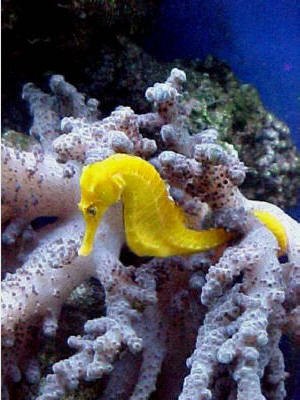 |
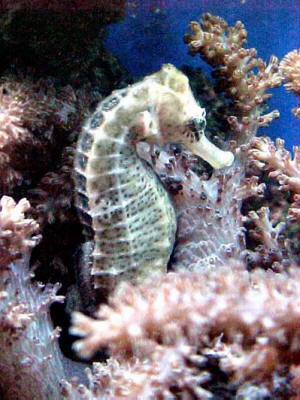 |
|
A dazzling SunFire shows the brilliant coloration that is so
characteristic of these spectacular seahorses. Photo by Leslie
Leddo |
This is the same SunFire after it has adopted cryptic coloration. If
you didn't know better, you would never suspect that this is the
same individual as the bright yellow seahorse shown in the previous
photograph. Photo by Leslie Leddo |
On the other hand, Sunbursts are a different
color morph of H. erectus that has also been developed by Ocean Rider.
Sunbursts are equipped with a full range of chromatophores (pigment cells) and
can display a wide range of colors, but as their name suggests, they are
predisposed towards the sunset colors (yellow, gold, peach and orange) when
conditions are to their liking. They have proportionally fewer melanophores
(black pigment cells) than Mustangs, which are typically dark brown or black, so
the background or base coloration of the Sunbursts tends to be lighter. Yellow
and orange specimens predominate, but they also display whitish, tan, pearly and
even brown color phases at times. Hobbyists can expect their Sunbursts to
go through a number of color phases and color changes over the months.
The hobbyist should also be aware that there are
any number of environmental conditions and hormonal influences that can affect
the coloration of seahorses in the aquarium, often by affecting the ability of
chromatophores to contract and expand. These include the following factors:
Stress -- seahorses often respond to stress by
darkening.
Emotional state -- when excited, seahorses
typically brighten in coloration, reflecting a state of high arousal. On the
other hand, fear, anxiety and distress are generally accompanied by dark, somber
hues.
Social interactions -- seahorses often brighten
during their courtship displays; pair-bonded seahorses likewise brighten during
their morning greeting rituals, and rivals go through characteristic color
changes (see Part 1 of this article in the previous issue of Conscientious
Aquarist) during their confrontations and competitions.
Competition for mates -- dominant individuals
brighten; subordinate seahorses darken in submission.
Poor water quality -- high levels of nitrogenous
wastes (e.g., ammonia, nitrite or nitrate) can cause chromatophores to contract
and colors to fade.
O2/CO2 -- low oxygen levels (or high CO2 levels)
can cause colorful seahorses to fade and they will blanch when subjected to
hypoxic conditions.
Background colors -- seahorses will often change
color in order to blend in with their immediate surroundings.
Medications -- some antibiotics and
malachite-green-based remedies negatively affect color (Cusick, 2000).
Tankmates -- seahorses may change their base
coloration to blend in with the rest of the herd or to match their mate (or a
potential partner). This can work both ways: a dark seahorse may brighten up and
assume vivid hues when introduced to an aquarium with bright yellow or orange
tankmates, just as a brightly colored seahorse may darken and adopt subdued
coloration when placed amidst drab tankmates. Of course, seahorses are not
responding to peer pressure when they conform in this manner; rather, this is
probably instinctive behavior. In nature, it's not healthy to be too conspicuous
and stick out in a crowd since an individual that stands out from the rest of
the herd draws the attention of potential predators to itself.
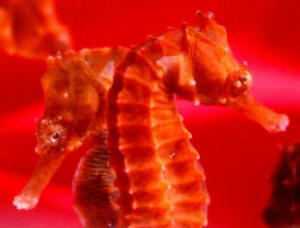 |
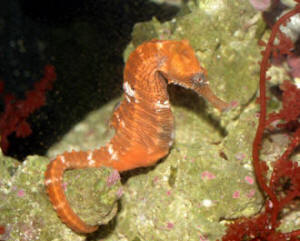 |
|
Blazing Beauties: this pair of Fire
Reds displays the flaming finery that has made this Ocean Rider
strain so popular with hobbyists. Only seahorses with red
chromatophores are capable of displaying colors such as scarlet and
crimson."
Photo by Dr. Clyde Tamaru
|
A boldly-marked Pinto from Ocean Rider, like this striking specimen,
is the crown jewel in many proud seahorse keepers' collections. To
keep vivid seahorses like this looking their best and brightest,
it's important to provide them with a stress-free environment,
colorful natural surroundings, a nutritious diet rich in
carotenoids, and optimum water quality. Photo by Leslie Leddo |
Temperature -- chromatophores tend to contract at
high temperatures (above the seahorse's comfort zone), causing colors to fade;
cooler temps within their optimal range can make pigment cells expand, keeping
colors bright.
Disease -- skin infections (bacterial, fungal, or
parasitic) can cause localized loss of pigmentation or discoloration of the
affected areas.
Diet -- seahorses cannot synthesize the pigments
used in their chromatophores. It is therefore important to enrich their food
with pigments such as carotenoids in a form that's easy for them to absorb. If
color additives are not provided, the chromatophores will gradually lose their
pigments and the seahorse's color can fade (Giwojna, 2002). Vibrance, for
example, is exceptionally rich in Vitamins A and C as well as natural
carotenoids, which are not found in the frozen Mysis that serves as the staple
diet for most seahorses. This is important because the carotenoids are a class
of yellow to red pigments, which include the carotenes and the xanthophylls
(Giwojna, 2002). Like all cells, individual pigment cells have a limited life
expectancy in the body and must be regularly renewed. Marine organisms cannot
synthesize carotenoids, so if they do not receive adequate amounts in their
diet, they will have difficulty replenishing their red and yellow pigments
(Giwojna, 2002). This means that the colors of bright yellow, orange, and red
seahorses will gradually fade over time if their daily diet is lacking in
carotenoids. So don't neglect the enrichment step in your daily feeding regimen!
If seahorses are fed a strict diet of Mysis without additional
enrichment, they may begin to develop dietary deficiencies over time, and both
their health and coloration will eventually suffer (Giwojna, 2002).
Lighting -- seahorses may darken in response to
UV radiation or excessively bright lighting, producing excess melanin as a
protective measure, whereas bulbs that emit wavelengths of light shifted towards
the red end of the visual spectrum (i.e., Grolux fluorescent tubes) can greatly
enhance the coloration of red, orange or purplish seahorses to the point that
they almost literally glow.
All of the different factors mentioned above need
to be addressed in order to keep your seahorses looking their brightest
For instance, this is what I recommended in that regard in an article titled,
"Ocean Rider: A Horse of a Different Color," which appeared in the June 2002
issue of FAMA magazine:
All seahorses may respond
to stress by darkening and expanding their melanophores to signal their
distress (Giwojna, 2002). When that happens, it doesn't matter how
brilliant their normal coloration may be, since the melanin absorbs the
entire visible spectrum (black is essentially the absence of color) and none
of the underlying colors are able to shine through (Giwojna, 2002).
Consequently, seahorses may never color-up and look their best if subjected
to dubious water quality, unacceptable aquarium parameters, an inadequate
diet, or other stressful conditions.
When setting up and
maintaining your seahorse tank, your primary goal must therefore be to
provide your seahorses with a stress-free environment that meets all of
their requirements. Begin by making sure your saltwater tank is
properly cycled and by maintaining your water quality within the following
parameters: pH 8.2-8.4, specific gravity 1.021-1.025, temperature 72°F-75°F
(Giwojna, 2002). Those are the optimal readings for most of the
cultured tropical seahorses that are now available. Strive for stable
readings within those limits, and maintain zero ammonia and nitrite at all
times (Giwojna, 2002).
Elevated nitrates are also
stressful to seahorses over the long term, and can keep your seahorses from
looking their brightest. For best results, consider using live rock
and/or a live sand bed (preferably situated in your sump) in conjunction
with a good protein skimmer to help filter your seahorse setup (Giwojna,
2002). The skimmer will remove excess organic compounds before they enter
the nitrogen cycle, and live rock and a deep sand bed will provide
significant denitrification ability, all of which will help keep your
nitrates down (Giwojna, 2002). Don't overstock, don't overfed, remove
leftovers promptly (a good clean-up crew is useful here), practice good
aquarium maintenance and maintain a sensible schedule for water changes
(Giwojna, 2002)
Some potential stressors,
such as shock and vibration or excess noise and traffic, can be eliminated
altogether during the planning stage. The medium of water transmits
certain sounds wonderfully well--far better than air, in fact--and like all
fishes, seahorses have organs specially designed to detect such vibrations,
and are sensitive to external noises and outside sources of shock and
vibration (Giwojna, 2002). Whether it's a clunky air pump or
compressor, the buzzing ballast from an aquarium reflector, the rattling
impeller from a noisy power filter, or something totally unrelated to the
aquarium, like a nearby clothes washer/dryer, dishwasher, stereo, television
or some such appliance, any source of bad vibes can subject seahorses to
chronic low-level stress (Giwojna, 2002). Footfalls and nonstop
passersby in heavy traffic areas can also be alarming to wild-caught
seahorses, and when they feel threatened they react by darkening or assuming
cryptic coloration, resorting to camouflage in order to conceal themselves
in the face of potential danger (Giwojna, 2002). (Note: this is not a
concern with domesticated seahorses, which are very social, highly
gregarious animals that are very much accustomed to the human presence.
They will thrive in a high traffic area such as your living room or den or
family room.)
To avoid this sort of
stress, choose the location for your seahorse tank with care, dampen all
potential sources of shock and vibration, and provide a thick pad (cork or
Styrofoam is ideal) beneath the tank to deaden vibrations and soften any
shocks that might otherwise be absorbed through the base of the aquarium.
If you're keeping skittish wild-caught seahorses, the aquarium should be
situated in a relatively quiet room away from major traffic areas, blasting
stereos, blaring TVs and noisy kids (Giwojna, 2002). If you have
modified your laundry room, utility room, or workshop so it can do double
duty as your fish room, you may want to find a less mechanically cluttered
area for your seahorses (Giwojna, 2002).
Stray voltage is another
common cause of chronic stress for seahorses and other aquarium inhabitants,
as well as a much more prevalent problem than most hobbyists suspect
(Giwojna, 2002). Installing a grounding probe in the tank easily
prevents it, and every seahorse setup should be equipped with one. A
titanium grounding probe is an inexpensive investment that can safeguard the
health of your seahorses (Giwojna, 2002). Think of it as an
extraordinarily cheap, yet effective life insurance policy that can save
your fish-and your hide-in the event of an electrical accident while working
on your tank.
As previously discussed,
diet also plays an important role in keeping your seahorses healthy and
looking their best. Captive-bred-and-raised seahorses are trained to
eat a diet of frozen Mysis enriched with Vibrance. In my
opinion, the freshwater Mysis relicta (from Piscine Energetics) are a
super food for seahorses, extremely rich in protein and essential fats.
In general, the total fat content of freshwater feeder fish and inverts
(e.g., FW ghost shrimp and glass shrimp) is shockingly low, but Mysis
relicta is a remarkable exception which has several times the fat levels
of even highly desirable marine feeder organisms such as saltwater
Penaeus shrimp (Giwojna, 2002). But as nutritious as it is,
Mysis relicta is not a suitable long-term diet for seahorses on its own,
and Vibrance has been specially formulated to add certain vitamins,
minerals, and additional long chain fatty acids that M. relicta lacks
(Giwojna, 2002).
For instance, Vibrance
contributes high levels of HUFAs (highly unsaturated fatty acids) including
the DHA omega 6 and omega 3 series, which are extra long chain fatty acids
that are absent in virtually all live and frozen feeds (Giwojna, 2002). Most
marine organisms, seahorses included, cannot synthesize these long chain
fatty acids and must obtain them through their diet. DHA, for
instance, has been proven to be essential to high survivability, nerve
development, stress management, and proper reproduction in fishes (Giwojna,
2002). The combination of Mysis relicta enhanced with Vibrance
is a superb, nutritionally complete diet for seahorse that contains
everything they need for vibrant good health and long-term survival
(Giwojna, 2002). And as we've already discussed, Vibrance is also
exceptionally rich in Vitamins A and C as well as natural carotenoids, which
are not found in Mysis
relicta. It will provide your seahorses with the pigments they
require to keep their colors vivid.
Aside from providing your
seahorses with optimal water quality, a stress-free environment, and an
ideal, enriched staple diet, you must also take care to furnish your
aquarium in a manner that will encourage them to display their brightest
colors.
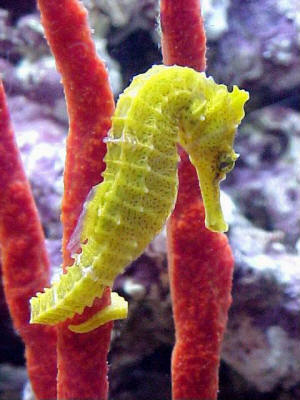 |
|
Real or artificial, living or
cured, it doesn't seem to make a difference -- branching sponges
are veritable magnets for seahorses. Colorful natural hitching
posts like this will encourage brightly colored seahorses such
as this Ocean Rider
Hippocampus erectus
to
retain their vivid wardrobes."
Photo
by Leslie Leddo |
In a drab, largely
monochromatic setting, seahorses may never look their best (Giwojna, 2002).
For instance, if you introduce your Sunbursts or Brazilian seahorses to an
aquarium decorated primarily with the bleached white bones of coral
skeletons and a substrate of dolomite, crushed coral or coral sand, you can
expect their bright hues to fade quickly. Seahorses rely on crypsis
and their ability to blend into their background in order to avoid predators
and stay out of trouble, and brightly colored seahorses will feel vulnerable
and exposed in such a bleached coral seascape (Giwojna, 2002). They
will either adopt pale colors or a generalized, drab, nondescript, cryptic
color pattern that makes them less conspicuous. The same is true if
their tank features algae-covered rock, loads of Caulerpa, and lots
of other macroalgae, and is dominated by browns and greens. Bright red
and orange seahorses may not feel at home amidst algal mats or this sort of
seagrass habitat, and are apt to revert to earth tones, cryptic patterns, or
shades of olive drab (Giwojna, 2002).
Therefore, in order to
show off your colorful seahorses to full effect and encourage them to live
up to their potential and retain their true brilliance, it's a good idea to
provide them with a colorful natural setting that will make them feel right
at home (Giwojna, 2002). This means furnishing their aquarium with
appropriate, multi-colored décor. Reef tanks featuring colorful
sponges, mushrooms, leathers, and other seahorse-safe soft corals and
gorgonians are ideal, guaranteed to keep seahorses feeling right at home and
looking their best (Giwojna, 2002). If you're not a reefer, you can
often achieve the same effect using "faux" coral, plastic gorgonians and
replicas of marine plants to encourage them to retain their natural
coloration. Various types of Caulerpa, Gracilaria, and other
attractive macroalgae can then be added to give your tank a welcome touch of
green, red, gold and add a bit of living color (Giwojna, 2002). Many
hobbyists find that a dark substrate, such as black sand, brings out their
seahorses' brightest colors and sets off their vivid hues exceptionally
well, as well as being aesthetically pleasing (Giwojna, 2002).
Pay special attention to
the hitching posts you select. Strive for bright reds, oranges, and yellows
in anything your seahorses may adopt as a holdfast (Giwojna, 2002).
These aquatic equines -- especially the stallions -- will often choose one
particular hitching post as their home base and spend much of there time
perched right there (think of your Dad hunkered down in his favorite easy
chair in the den). Once they adopt a favorite base of operations like
this, they will often proceed to change coloration to match their preferred
resting spot (Giwojna, 2002). So you want to encourage them to adopt
one of the more vivid pieces as a favorite holdfast.
Mildred Bellomy provides a perfect example of how
this works in the Encyclopedia of Seahorses:
Elizabeth Goetz of Miami,
Florida has kept one or more seahorse stables in her home for many years.
She wrote the following anecdote about one of her seahorses that "turned red
with envy."
"About five or six years
ago, it was just about this time of year, [Christmas], we began our holiday
decorating. Our own is not the simplest place to decorate for special
occasions in that we have so many aquariums -- approximately 35 at the time.
Fourteen of these tanks were the homes of seahorses (Hippocampus
hudsonius). [Author's note: Hippocampus hudsonius is an
outdated synonym for Hippocampus erectus.]
"After completing the
superficial home decorating, we decided it would be a grand idea to really
go all-out with the holiday scheme and include the aquariums. On
checking through our collection of assorted Christmas bric-a-brac, we found
a number of ceramic items suitable for display in sea water. There
were Christmas trees in north-woods green, gaily ornamental angels lovely
enough to have stepped from the very gates of Heaven, winged carolers,
haloed mermaids, etc., and lo and behold! -- one, red-robed, sitting Santa
Claus, with the most adorable facial expression one could imagine.
Here, then, was ample material to decorate to one's heart's content.
"The walls of the dining
room are lined with 10- and 15-gallon aquariums so we chose the most
prominent 15-gallon tank for this pixie-like Santa. This was the home
of five seahorses and they, too, seemed really happy with the decorating
idea. We will not argue the point that any other smooth ceramic piece
would have pleased them equally, but it is more satisfying to believe that
the seahorses joined in with the holiday spirit. Nevertheless, almost
as soon as their former hitching posts were removed and a Christmas item put
in its place, the seahorses wrapped their respective tails around the new
items and were completely at home again. Though scientists may
adamantly disagree, we firmly believe fish do have varied personalities,
even within their own species. Ask any hobbyist. We have had
friendly seahorses, unfriendly ones, and downright cussed critters; the
timid, placid, bold, and boisterous, and all of these and more personality
traits were observed in
H. hudsonius alone.
"All of the foregoing is
merely to set the stage for our tale of the seahorse that turned red with
envy.
"Our little seahorse star
of this story was the most calm and timid of the five in our Santa aquarium.
He would cruise calmly from his hitching post for exercise and return to his
own station a short distance from the Santa, never trying to usurp the
throne of another of his tankmates. The others did claim Santa as a
resting place. Seldom was the time when Santa didn't have the tail of
a seahorse wrapped gently around an arm that rested on his pack, or around
the tipped-up tassel of his toboggan. Our calm but "envious one" would
stare in Santa's direction almost constantly, while resting. It might
be well, at this point, to emphasize that Santa was the only red-colored
object or part of this aquarium. This previously dark (brownish)
seahorse -- originally colored the same as the other four -- turned bright
red. His change occurred gradually, over a period of about a week and
it is quite true, he became a most beautiful red for the holidays."
Now we are well aware of
color changes in nature, assumedly for protective measures, and being
mindful of the fact that this timid little fellow did not cling to red-robed
Santa, but remained some distance away, what then could the
whimsical-minded, season-inspired person presumed other than that the most
peace-loving seahorse in the aquarium bathed himself in the reflected glory
of the mythical man-of-the-hour, the one and only Santa Claus.
Notice that the seahorse reverted to its usual
dark brown coloration when the scarlet-clad Claus figurine was removed from the
aquarium after the holidays.
The moral of this story is that you can never
tell what might catch your seahorse's eye and trigger a corresponding color
change in response to a change in its immediate environment. With that in
mind, some hobbyists have experimented with brightly colored aquarium
backgrounds and achieved surprising results. For instance, I have received
reports that a bright orange aquarium backing can stimulate vivid color changes
in some seahorses (Abbott 2003), although the result is often not what you would
expect. (One wonders if Hippocampus perceives all colors the same way we
do.) Don't hesitate to experiment until you find the right combination
that works well for both you and your seahorses.
Transitory color changes can be achieved rapidly, in a matter of
moments, but long lasting transformations occur gradually, and may take days to
complete. This is often the case when a seahorse adopts a favorite
hitching post and makes it his home base or center of operations.
When that happens, the seahorse will often assume
a color that closely matches its chosen resting spot so it blends in with its
background when hanging out at headquarters. This is akin to the situation
with the ceramic Santa; the color matching occurs slowly and, once the
transformation is complete, the seahorse intends to keep its new coloration
indefinitely.
 |
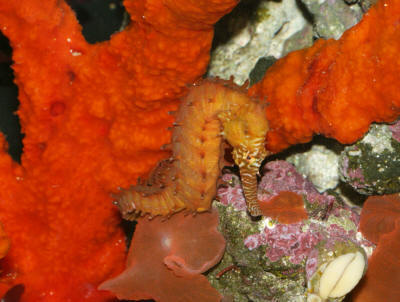 |
|
Seahorses will also naturally gravitate towards colorful gorgonians
and often select them as their favorite holdfast or hitching posts,
so gorgonia are also excellent choices for aquascaping the seahorse
tank. |
Seahorse Heaven: providing you can
care for them properly, colorful tree sponges are everything both
you and your seahorse are looking for in terms of aquarium decor.
Red or orange seahorses, like this Ocean Rider Hippocampus barbouri,
will feel right at home in an aquarium that provides them with tree
sponges of similar color to use as hitching posts."
Photo by Leslie Leddo |
A good way to tip the odds in your favor is to
acquire one or more tree sponges for your seahorse tank. Tree sponges are
usually brightly colored (red and orange shades are common) and their shape and
texture seem to make them irresistible to seahorses as hitching posts (Giwojna,
2002). Real or artificial, living or cured, it doesn't seem to make a
difference -- branching sponges are veritable magnets for seahorses. Very
often, all the seahorses in the tank can be found clinging to the same tree
sponge together, eschewing other nearby holdfasts that appear every bit as comfy
and attractive to human eyes (Giwojna, 2002). Tree sponges are everything
both you and your seahorses are looking for in terms of aquarium décor.
In short, provide your seahorses with optimal
water quality, a nutritious diet rich in carotenes and natural color enhancers,
and a complex stress-three environment with colorful aquascaping, and they will
reward you with vibrant good health and remain at their peak of coloration.
References
Abbott, Alisa Wagner. 2003. The Complete Guide to Dwarf
Seahorses in the Aquarium. Neptune City, NJ: TFH Publications.
Bellomy, Mildred D. 1969. Encyclopedia of
Seahorses. Jersey City, NJ: TFH Publications.
Cusick, Terry. 2000. "Where'd the
Color Come From?" Barbels: Selected Articles. Mar. 2000 (accessed 2 Feb. 2004).
<http://www.nfkc.info/barbels003.htm>
Giwojna, Pete, unpublished text. Complete
Guide to the Greater Seahorses in the Aquarium. Neptune City, New Jersey:
TFH Publications.
Giwojna, Pete. Jun. 2002. "Ocean
Rider: A 'Horse of a Different Color, Part II." Freshwater and Marine
Aquarium
Tamaru, Dr. Clyde, and Carol Cozzi-Schmarr.
Sep. 2001. "Horse Forum." Freshwater and Marine Aquarium.
<http://www.oceanrider.com/articledetail.asp?ArtNo=8> (accessed 28 Jan.
2004), part of Ocean Rider Articles
<http://www.oceanrider.com/articles.asp>
Wallis, Catherine. 2004. Seahorses:
Mysteries of the Oceans. Bunker Hill Publishing Inc. Charleston, MA 02129.
USA
Pete Giwojna 1/21/12
Hi Bob, I wanted to ask Pete Giwojna a few
questions about a few of his articles. Do you have a
number, maybe his email address? Thanks, Jim
<Mmm, I don't give out others contact info., but have
Bcc'd Pete here, and if this doesn't work, I'd suggest
trying to write him through OceanRider.com
BobF>
